Author: Philip L. Fuchs, André B. Charette, Jeffrey W. Bode, Tomislav Rovis
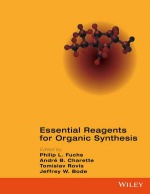
|
Call no. QD77 E78 2016
Book Description From Boron Trifluoride to Zinc, the 52 most widely used reagents in organic synthesis are described in this unique desktop reference for every organic chemist. The list of reagents contains classics such as N-Bromosuccinimide (NBS) and Trifluoromethanesulfonic Acid side by side with recently developed ones like Pinacolborane and Tetra-n-propylammonium Perruthenate (TPAP).
For each reagent, a concise article provides a brief description of all important reactions for which the reagent is being used, including yields and reaction conditions, an overview of the physical properties of the reagent, its storage conditions, safe handling, laboratory synthesis and purification methods. Advantages and disadvantages of the reagent compared to alternative synthesis methods are also discussed. Reagents have been hand-picked from among the 5000 reagents contained in EROS, the Encyclopedia of Reagents for Organic Synthesis. Every organic chemist should be familiar with these key reagents that can make almost every reaction work. (books.google.co.th) |
Author: Kristian Stromgaard, Povl Krogsgaard-Larsen, Ulf Madsen
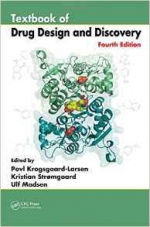
|
Call no. QD77 E78 2016
Book Description Building on the success of the previous editions, the Textbook of Drug Design and Discovery, Fifth Edition, has been thoroughly revised and updated to provide a complete source of information on all facets of drug design and discovery for students of chemistry, pharmacy, pharmacology, biochemistry, and medicine. The information is presented in an up-to-date review form with an underlying and fundamental focus on the educational aspects.
Beginning with an introduction to drug design and discovery, the first eight chapters cover molecular recognition, ligand-based drug design, and biostructure-based drug design. The authors also discuss drug-like properties and decision making in medicinal chemistry, chemical biology, natural products in drug discovery, and in vivo imaging in drug discovery. The middle six chapters provide an overview of peptide and protein drug design, prodrugs in drug design and development, and enzyme inhibitors. The authors also go through receptors (structure, function, and pharmacology), ion channels (structure and function), and neurotransmitter transporters (structure, function, and drug binding). The following chapters address important neurotransmitter systems, GABA and glutamic acid receptors and transporter ligands, acetylcholine, histamine, dopamine and serotonin, and opioid and cannabinoid receptors. The book concludes with an examination of neglected diseases, anticancer agents, tyrosine kinase receptors, and antibiotics. (books.google.co.th) |
Author: Kristian Stromgaard, Povl Krogsgaard-Larsen, Ulf Madsen
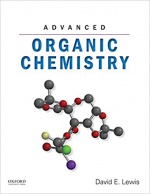
|
Call no. QD251.3 L637A 2016
Book Description Written by a master teacher, Advanced Organic Chemistry presents a clear, concise, and complete overview of the subject that is ideal for both advanced undergraduate and graduate courses. In contrast with many other books, this volume is a true textbook, not a reference book. (amazon.com)
|
Author: Council of Europe; European Pharmacopoeia Commission.
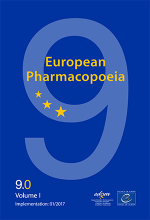
|
Call no. Ref. RS141 .28 E89 2016
Book Description The European Pharmacopoeia (Ph. Eur.) is Europe’s legal and scientific benchmark for pharmacopoeial standards which contribute to delivering high quality medicines in Europe and beyond. Cover of the European Pharmacopoeia 9th editionThe Ph. Eur. is applicable in 38 European countries and used in over 100 countries worldwide. It delivers crucial information earlier than any other pharmacopoeia – the 9th Edition was released in mid-2016. With 121 new and 1,403 revised texts, over 50% of the 9th Edition’s content is new compared to the 8th Edition.
|
Author: Jacobsen, Neil E.
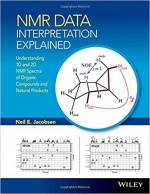 |
Call no. Ref. QD96.N8 J17N 2017
Book Description Through numerous examples, the principles of the relationship between chemical structure and the NMR spectrum are developed in a logical, step-by-step fashion
Includes examples and exercises based on real NMR data including full 600 MHz one- and two-dimensional datasets of sugars, peptides, steroids and natural products
Includes detailed solutions and explanations in the text for the numerous examples and problems and also provides large, very detailed and annotated sets of NMR data for use in understanding the material
Describes both simple aspects of solution-state NMR of small molecules as well as more complex topics not usually covered in NMR books such as complex splitting patterns, weak long-range couplings, spreadsheet analysis of strong coupling patterns and resonance structure analysis for prediction of chemical shifts
Advanced topics include all of the common two-dimensional experiments (COSY, ROESY, NOESY, TOCSY, HSQC, HMBC) covered strictly from the point of view of data interpretation, along with tips for parameter settings (amazon.com)
|
Author: Prechtl, Martin H. G [editor].

|
Call no. QC176.8 N185 2017
Book Description Edited and written by renowned experts in the field, this is the first book to reflect the state of the art of nanocatalysis in ionic liquids.Divided into two core areas, the first part of the book describes the different classes of metal nanoparticles as well as their synthesis in ionic liquids, while the second focuses on such emerging issues as the application of such systems to energy and biomass conversion. (amazon.com)
|
Author: Ladd, Mark; [editor].
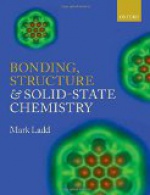
|
Call no. QD478 L154B 2016
Book Description This book provides a study in Bonding, Structure and Solid State Chemistry. It is based on lecture courses given over several years, but is not directed at any particular degree course. Thus, it will find a place in all years of first-degree courses in both chemistry and those subjects for which chemistry forms a significant part. It will also prepare readers for more intensive study in the title topics. Pre-knowledge is assumed in mathematics and physical sciences at about final year high school level. Additional mathematical and other topics are presented where necessary as appendices, so as not to disturb the flow of the main text. The book is copiously illustrated, including many stereoscopic diagrams (with practical advice on correct viewing) and colour illustrations. A suite of computer programs, some of which are interactive, has been devised for the book and is available on-line from the publisher’s website, global.oup.com/booksites/content/9780199670888. They are available for both 32- and 64-bit operating systems, and are easily executed on a PC or laptop; notes on their applications are provided. Problems have been devised for each chapter and fully worked ‘tutorial’; solutions are included. After an introductory chapter, the book presents a study based on the main interactive forces responsible for cohesion in the solid state of matter. No classification is without some ambiguity, but that chosen allows for a structured discussion over a wide range of compounds. Each chapter includes worked examples on the study topics which, together with the problems provided, should ensure a thorough understanding of the textual material. (amazon.com)
|
Author: Johnson, Dale E [editor].
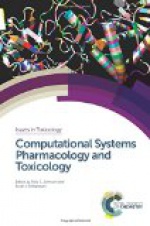
|
Call no. RA1193.4 C737 2017
Book Description The network approaches of systems pharmacology and toxicology serve as early predictors of the most relevant screening approach to pursue both in drug discovery and development and ecotoxicological assessments. Computational approaches have the potential to improve toxicological experimental design, enable more rapid drug efficacy and safety testing and also reduce the number of animals used in experimentation. Rapid advances in availability of computing technology hold tremendous promise for advancing applied and basic science and increasing the efficiency of risk assessment.
This book provides an understanding of the basic principles of computational toxicology and the current methods of predictive toxicology using chemical structures, toxicity-related databases, in silico chemical-protein docking, and biological pathway tools. The book begins with an introduction to systems pharmacology and toxicology and computational tools followed by a section exploring modelling adverse outcomes and events. The second part of the book covers the discovery of protein targets and the characterisation of toxicant-protein interactions. Final chapters include case studies and additionally discuss interactions between phytochemicals and Western therapeutics. |
Author: Mizoguchi, Kenji [editor].
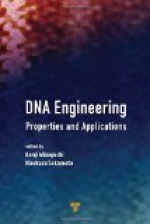
|
Call no. RA1193.4 C737 2017
Book Description This book presents basic information about DNA, along with comprehensive theoretical introduction to DNA. It discusses recent developments in divalent-metal-ion inserted M-DNA complex, which gives rise to the possibility of DNA application to electronic functionality. Further, the book describes three examples of applications: optical and electrical materials, electronic devices such as bioTFT memory and color-tunable light-emitting diodes, and biofuel cell application with use of proton conduction in DNA. (amazon.com)
|
Author: Rosner, Bernard.
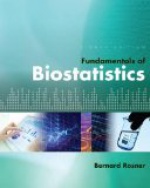
|
Call no. QH323 .5 R822F 2016
Book Description FUNDAMENTALS OF BIOSTATISTICS leads you through the methods, techniques, and computations of statistics necessary for success in the medical field. Every new concept is developed systematically through completely worked out examples from current medical research problems. (amazon.com)
|
Author: Sherley, James L [editor].
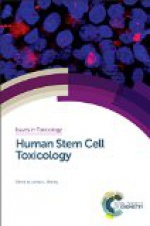
|
Call no. QH588.S83 H918 2016
Book Description Toxicity against tissue stem cells (TSCs) is a major problem in drug development and environmental health science. Despite their essential function in all human cellular tissues, the nature of tissue stem cells is not fully understood. The small fraction of stem cells in tissues and the lack of specific biomarkers for their quantification present a formidable challenge to developing tools for their study and assays that can identify stem cell-toxic agents.
Human Stem Cell Toxicology reveals TSC toxicity as a biomedical reality that is now well under siege by newly emerging ideas and technologies, despite these challenges. Chapters consider stem cell toxicity by environmental agents, pharmaceutical drug candidates, and marketed therapeutic medicines with adverse side effects. New insights to cellular, molecular, biochemical, and chemical mechanisms of human tissue stem cell toxicity are brought together. Experimental and theoretical treatments are of specific topics, including approaches to monitoring TSC function, newly discovered TSC types and TSC toxicity resistance mechanisms, are covered by expert authors. This book informs and champions the continued development of innovative technologies to predict the TSC toxicity of compounds before their use, whether in patients or the environment, by addressing emerging new cell-based approaches and concepts for technical innovation. This publication will be a useful reference for postgraduate students and researchers working in toxicology, pharmaceutical science, tissue cell biology and stem cell biology. (amazon.com) |
Author: Shukla, Pratyoosh
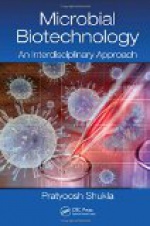
|
Call no. QR46 S562 2017
Book Description Microbial Biotechnology: An Interdisciplinary Approach covers all aspects of microbial biotechnology, whilst bringing the field of functional foods and microbial bioremediation to the fore. Recounting the interdisciplinary scope of biotechnology and its discoveries, this text presents innovative ideas in the field of emerging biotechnology providing the scientific community with a much needed new resource.
Acting as an important means of information for researchers working in interdisciplinary areas of research, this text:
Envisages the recent ideas of novel findings in microbiology
Provides insight into the various interdisciplinary research avenues
Uniquely covers a diverse range of topics
Presents groundbreaking new findings in key areas of modern biotechnology
Enhanced and straight forward descriptions cater to the needs of researchers working in areas of bacterial exopolysaccharides, microalgal proteomics, applications of Microbial L-asparaginases, novel aspects of bioremediation, Probiotics and their impact on society, and microbial community analysis in waste water treatment techniques. It will also prove crucial reading for senior undergraduate and graduate students and professionals working in areas of modern biotechnology. (amazon.com)
|
Author: Moerri, Antonio [editor].
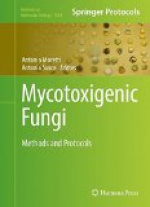
|
Call no. QP631 M995 2017
Book Description This thorough volume explores the possibility of detecting and identifying toxigenic fungi, able to produce secondary metabolites known as mycotoxins, which cause severe health problems in humans and animals after exposure to contaminated food and feed, having a broad range of toxic effects, including carcinogenicity, neurotoxicity, and reproductive and developmental toxicity. Beginning with a section on fungal genera and species of major significance along with their associated mycotoxins, the book continues with sections on Polymerase Chain Reaction (PCR)-based methods for the detection and identification of mycotoxigenic fungi, PCR-based methods for multiplex detection of mycotoxigenic fungi, as well as sections on combined approaches and new methodologies. Written for the highly successful Methods in Molecular Biology series, chapters include introductions to their respective topics, lists of the necessary materials and reagents, step-by-step, readily reproducible laboratory protocols, and tips on troubleshooting and avoiding known pitfalls.
Authoritative and practical, Mycotoxigenic Fungi: Methods and Protocols will aid researchers working in this vital field to provide insight into possible actions to reduce mycotoxin contamination of crop plants and the food/feed byproducts. (amazon.com) |
Author: Klipp, Edda
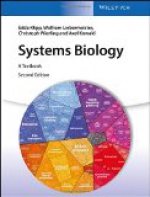
|
QH308.2 S995 2016
Book Description This advanced textbook is tailored for an introductory course in Systems Biology and is well-suited for biologists as well as engineers and computer scientists.
It comes with student-friendly reading lists and a companion website featuring a short exam prep version of the book and educational modeling programs. The text is written in an easily accessible style and includes numerous worked examples and study questions in each chapter. For this edition, a section on medical systems biology has been included.(amazon.com) |
Author:Campbell, Mary K; Farrell, Shawn [jt. auth].
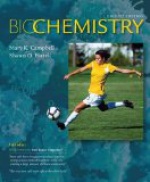
|
QD415 C189B 2015
Book Description Introduce your students to the latest developments in biotechnology and genomics with this new edition of Campbell and Farrell’s best-selling text for the one-term course. Known for its logical organization, appropriate depth of coverage, and vibrant illustrations, BIOCHEMISTRY, 8th Edition, helps your students synthesize the flood of information that has inundated the field since the decoding of the human genome, while showing them how biochemistry principles connect to their everyday lives. The book incorporates up-to-date developments in stem cell research, cloning, and immunology and offers revised coverage of major topics, such as Molecular Biology. Balancing scientific detail with readability, the book is ideal for students studying biochemistry for the first time. For example, in-text questions and problem sets categorized by problem type help students master chemistry and prepare for exams, and “Biochemical Connections” demonstrate how biochemistry applies to other fields such as health and sports medicine. In addition, the book’s revised state-of-the-art visual program improves learning outcomes and its innovative magazine articles, “Hot Topics in Biochemistry” now reflect the latest advances in the field. Count on BIOCHEMISTRY, 8th Edition, to lead the way in currency, clarity, and innovation for your one-semester biochemistry course. (amazon.com)
|
Author: Pollad, Thomas D.
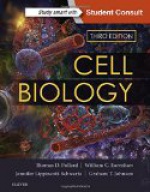 |
QH581.2 P772C 2017
Book Description The much-anticipated 3rd edition of Cell Biology delivers comprehensive, clearly written, and richly illustrated content to today’s students, all in a user-friendly format. Relevant to both research and clinical practice, this rich resource covers key principles of cellular function and uses them to explain how molecular defects lead to cellular dysfunction and cause human disease. Concise text and visually amazing graphics simplify complex information and help readers make the most of their study time. (amazon.com)
|
Author: Helgason, Cheryl D; Miller, Cindy L.
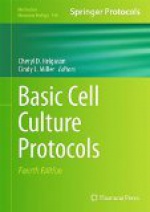 |
QH585.2 B311 2013
Book Description At some point in their careers, virtually every scientist and technician, as well as many medical professionals, regardless of their area of specialization have a need to utilize cell culture systems. Updating and significantly expanding upon the previous editions, Basic Cell Culture Protocols, Fourth Edition provides the novice cell culturist with sufficient information to perform the basic techniques, to ensure the health and identity of their cell lines, and to be able to isolate and culture specialized primary cell types. The intent of this extensive volume is to generate a valuable resource containing clear methodologies pertinent to current areas of investigation, rather than attempting to educate cell culturists on specific cell types or organ systems. Written in the highly successful Methods in Molecular Biology™, chapters include introductions to their respective topics, lists of the necessary materials and reagents, step-by-step, readily reproducible laboratory protocols, and tips on troubleshooting and avoiding known pitfalls. (amazon.com)
|
Author: Stanley, Lesley A; Cseke, Leland J.
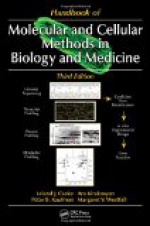 |
QH506 H236 2011
Book Description Several milestones in biology have been achieved since the first publication of the Handbook of Molecular and Cellular Methods in Biology and Medicine. This is true particularly with respect to genome-level sequencing of higher eukaryotes, the invention of DNA microarray technology, advances in bioinformatics, and the development of RNAi technology. Now in its third edition, this volume provides researchers with an updated tool kit that incorporates conventional as well as modern approaches to tackle biological and medicinal research in the post-genomics era.
Significantly revised to address these recent changes, the editors have evaluated, revised, and sometimes replaced protocols with more efficient, more reliable, or simpler ones. The book has also been reorganized with section headings focusing on different biological levels connected to one another, taking into account the central dogma of biology (DNA → RNA → protein → metabolites). The book first explores traditional approaches and then moves to the modern “omics” approaches, including genomics, proteomics, and metabolomics. It also discusses the manipulation of biological systems (including RNAi) and macromolecular analyses, focusing on the use of microscopy. In each chapter, various notes and cautionary considerations are presented for potentially hazardous reagents. Filled with diagrams, tables, and figures to clarify methods, most chapters also contain Troubleshooting Guides indicating problems, possible causes, and solutions that may be incurred in carrying out the procedures. Researchers and scientists who master the techniques in this book are putting themselves at the cutting edge of biological and medicinal research. (amazon.com) |
Author: Van Vranken, David L; Weiss, Gregory A.
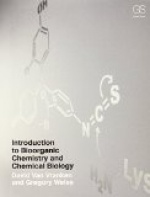 |
QD415 V978I 2013
Book Description Introduction to Bioorganic Chemistry and Chemical Biology is the first textbook to blend modern tools of organic chemistry with concepts of biology, physiology, and medicine. With a focus on human cell biology and a problems-driven approach, the text explains the combinatorial architecture of biooligomers (genes, DNA, RNA, proteins, glycans, lipids, and terpenes) as the molecular engine for life. Accentuated by rich illustrations and mechanistic arrow pushing, organic chemistry is used to illuminate the central dogma of molecular biology. (amazon.com)
|
Author: Luisi, P. L [ed.]; Chiarabelli, Cristiano [ed.].
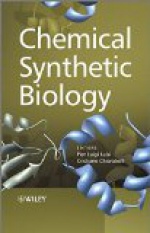 |
QD415 C514 2011
Book Description Chemistry plays a very important role in the emerging field of synthetic biology. In particular, chemical synthetic biology is concerned with the synthesis of chemical structures, such as proteins, that do not exist in nature. With contributions from leading international experts, Chemical Synthetic Biology shows how chemistry underpins synthetic biology. The book is an essential guide to this fascinating new field, and will find a place on the bookshelves of researchers and students working in synthetic chemistry, synthetic and molecular biology, bioengineering, systems biology, computational genomics, and bioinformatics. (amazon.com)
|
Author: Civjan, Natanya [ed.].
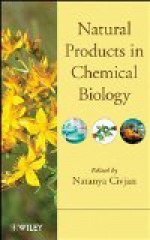 |
QH345 N285 2012
Book Description Based on the award winning Wiley Encyclopedia of Chemical Biology, this book provides a general overview of the unique features of the small molecules referred to as “natural products”, explores how this traditionally organic chemistry-based field was transformed by insights from genetics and biochemistry, and highlights some promising future directions. The book begins by introducing natural products from different origins, moves on to presenting and discussing biosynthesis of various classes of natural products, and then looks at natural products as models and the possibilities of using them in medicine. (amazon.com)
|
Author: Walsh, Christopher.
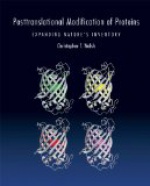 |
QH450 .6 W227P 2006
Book Description The number of protein isoforms in proteomes can be two to three orders of magnitude higher than the number of genes in the genomes. This is in large part due to posttranslational modifications of proteins that provide covalent alterations to protein backbones and side chains that increase proteome complexities. Greater than 5% of the genes in the human genome encode enzymes that perform such modifications, including hundreds of protein kinases and opposing phosphatases, ubiquitinyl ligases, acetylases and deacetylases, methyl transferases and glycosyl transferases. The major classes of posttranslational modifications (PTM) are codified according to types of residues modified, underlying chemistry, PTM catalysts, and biological consequences. This is the first comprehensive treatment of this burgeoning area of proteome diversification. (amazon.com)
|
Author: Tan, Zhongping
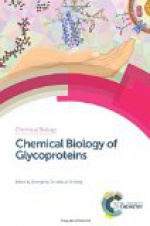 |
QP552.G59 C517 2017
Book Description Glycans play a vital role in modulating protein structure and function from involvement in protein folding, solubility and stability to regulation of tissue distribution, recognition specificity, and biological activity. They can act as both positive and negative regulators of protein function, providing an additional level of control with respect to genetic and environmental conditions. (amazon.com)
|
Author: Stephenson, Frank H.
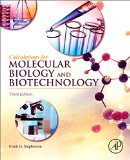 |
QH506 S828 2016
Book Description Calculations in Molecular Biology and Biotechnology, Third Edition, helps researchers utilizing molecular biology and biotechnology techniques―from student to professional―understand which type of calculation to use and why. Research in biotechnology and molecular biology requires a vast amount of calculations. Results of one data set become the basis of the next. An error of choosing the wrong type of equation can turn what would have been a successful research project or weeks of labor and research into a veritable house of cards. It could be how you calculated the medium in which you test your sample to calculating how long it takes a sample to grow to calculating the synthesis of multiple variables. (amazon.com)
|
Author: Renshaw, Simon [ed].
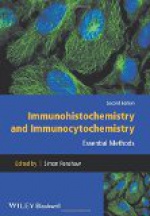 |
QR183.6 I34 2017
Book Description Immunohistochemistry and immunocytochemistry are invaluable tools for the visualization of tissue and cellular antigens in diagnostic and biological research environments. The need to obtain accurate, reliable and reproducible results is paramount.
It is with this fundamental aim in mind that we have compiled Immunohistochemistry: Essential Methods. We have achieved this by examining each aspect of immunochemistry in turn, with each chapter including detailed information regarding the subject matter in question. Each chapter is written by an expert in their field and includes protocols that are typically used in their own research. Subjects covered are, amongst others, antibodies and their production; selection of reporter labels; immunochemical staining methods and experimental design (both using single and multiple reporter labels); quality assurance; automated immunochemistry; confocal microscopy and electron microscopy. In addition, benefits and limitations of each approach are discussed within the chapters. (amazon.com) |
Author: Lee, Moo-Yeal; Korenberg, Michael J [ed.].
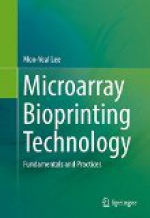 |
R857.B5 L479M 2016
Book Description This book introduces key fundamentals of microarray bioprinting, including the required chip platforms and associated instruments/devices, experimental protocols for cell printing and biochemical- and cell-based assays, and several example applications. Various bioprinting approaches that allow for the rapid testing of hundreds of different cell culture conditions in combinations on a single chip are discussed in detail. Also covered is high-content, 3D cell-based imaging assays of tissue functions on miniaturized tissue constructs for high-throughput, predictive screening of drug efficacy and toxicity. This is an ideal book for graduate and postgraduate students in the field of biomedical engineering as well as scientists in the pharmaceutical industry. (amazon.com)
|
Author: Mager, Donald E [ed]; Kimko, Holly H. C [ed].
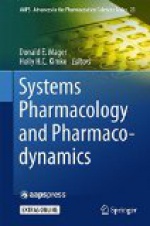 |
RM300 S995 2016
Book Description While systems biology and pharmacodynamics have evolved in parallel, there are significant interrelationships that can enhance drug discovery and enable optimized therapy for each patient. Systems pharmacology is the relatively new discipline that is the interface between these two methods. This book is the first to cover the expertise from systems biology and pharmacodynamics researchers, describing how systems pharmacology may be developed and refined further to show practical applications in drug development. There is a growing awareness that pharmaceutical companies should reduce the high attrition in the pipeline due to insufficient efficacy or toxicity found in proof-of-concept and/or Phase II studies. Systems Pharmacology and Pharmacodynamics discusses the framework for integrating information obtained from understanding physiological/pathological pathways (normal body function system vs. perturbed system due to disease) and pharmacological targets in order to predict clinical efficacy and adverse events through iterations between mathematical modeling and experimentation. (amazon.com)
|
Author: Colacot, Thomas J.
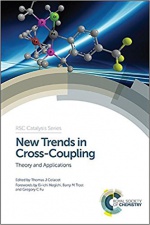 |
Call no. QD262 N561 2015
Book Description New Trends in Cross-Coupling provides the reader with the history and basic, concepts of cross-coupling up to the state of the art in modern coupling reactions from both technology and applied perspectives. A wide breadth of topics including selecting prominent ligand types; advances in Pd-phosphine precatalysts and Pd N-heterocyclic carbene complexes; new reactions such as carboiodination; implementation of new technologies such as continuous flow and advanced metal detection methods; greener approaches to cross-coupling; as well as large-scale applications in the syntheses of pharmaceutical materials are covered. Amazon.com
|
